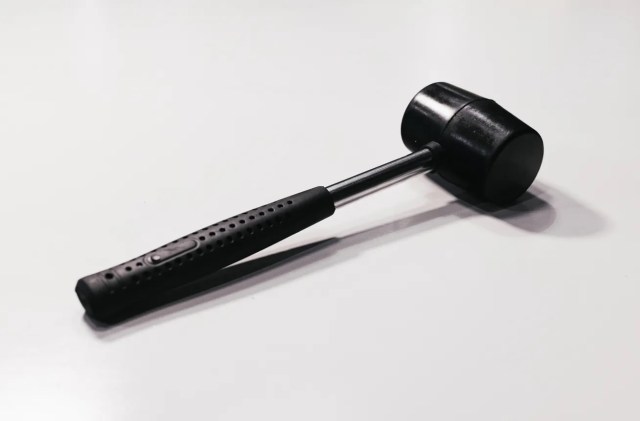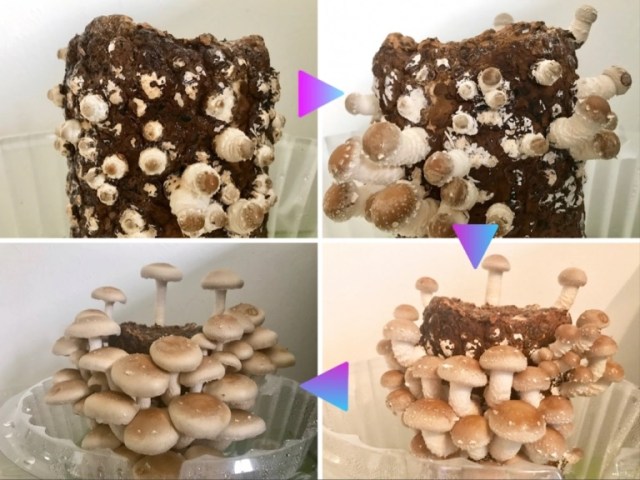
Swinging hammers now part of cultivating shiitake.
In Japan, there’s an image of elegance, some might even say nobility, associated with farming. Maybe it’s because you don’t have to go all that far back in Japan’s history to find a time when the country was still overwhelmingly agrarian, or perhaps it’s a carryover from Shinto beliefs about the divinity present in nature.
Regardless of the reason, though, Japan’s popular image of farmers is of people who work in reverent harmony with nature, delivering the fruits of their respectful labor to the nation’s dinner tables. So it’s a little jarring to learn that in one part of Japan, farmers aren’t just delicately sifting the soil, but smacking things with hammers.
▼ Get this man a pair of overalls, and he’ll be ready to go to work.
This technique is spreading among growers of shiitake mushrooms in Oita Prefecture, on Japan’s southwest island of Kyushu. A unique aspect of shiitake it that they won’t grow on the ground. Instead, shiitake need a tree trunk in order to form (or “fruit,” to use the technical verb).
▼ As we learned when we grew some shiitake of our own.
Shiitake growers can roughly predict when shiitake are going to start fruiting, and they’ve found that a simple and effective way to increase their yields is to spray the log with water about two weeks ahead of time, then grab a hammer and bang on the wood.
Strange as it may sound, the technique has been a bit of folk wisdom for some time, and the Oita Prefectural Agriculture, Forestry, and Fisheries Research Guidance Center recently confirmed that hammer time really does help lead to mushroom time.
Last month, the organization conducted an experiment, comparing the effects of hitting a log with a hammer versus leaving it un-smacked, and found that the wood that had been hammered subsequently produced more than twice as much shiitake (by weight). The center recommends farmers strike the log five times on one side, and then five more on the opposite side, adding that the most effective striking spot is on the bark of the log, away from its flat-cut edges.
Researchers aren’t sure why violence is the answer, except that subjecting the wood to vibrations somehow enhances shiitake formation on the log, and that hammering applies the necessary reverberations. The center hopes that greater adoption of the technique will lead to greater productivity for existing shiitake farmers and encourage newcomers to the profession, though it may or may not provide a plausible alibi during traffic stops.
Source: The Japan Agricultural News via Livedoor News via Hachima Kiko
Top image: Pakutaso
Insert image: Pakutaso, SoraNews24
● Want to hear about SoraNews24’s latest articles as soon as they’re published? Follow us on Facebook and Twitter!



 Oh shiitake! How to grow your own with Japan’s super-easy mushroom cultivation kit【Photos】
Oh shiitake! How to grow your own with Japan’s super-easy mushroom cultivation kit【Photos】 Japan’s ‘agri-tech’ farming revolution
Japan’s ‘agri-tech’ farming revolution Diarrhea-inducing mushrooms send three Japanese men to hospital after weekend-ruining barbecue
Diarrhea-inducing mushrooms send three Japanese men to hospital after weekend-ruining barbecue Mysterious bags of Japanese mushroom snacks are hard to get, create intrigue online
Mysterious bags of Japanese mushroom snacks are hard to get, create intrigue online Japanese shiitake mushroom snacks from Don Quijote, created for people who don’t like mushrooms
Japanese shiitake mushroom snacks from Don Quijote, created for people who don’t like mushrooms Historical figures get manga makeovers from artists of Spy x Family, My Hero Academia and more
Historical figures get manga makeovers from artists of Spy x Family, My Hero Academia and more Tokyo Tsukiji fish market site to be redeveloped with 50,000-seat stadium, hotel, shopping center
Tokyo Tsukiji fish market site to be redeveloped with 50,000-seat stadium, hotel, shopping center McDonald’s new Happy Meals offer up cute and practical Sanrio lifestyle goods
McDonald’s new Happy Meals offer up cute and practical Sanrio lifestyle goods Red light district sushi restaurant in Tokyo shows us just how wrong we were about it
Red light district sushi restaurant in Tokyo shows us just how wrong we were about it Pokémon Sleep camping suite and guestrooms coming to Tokyo Hyatt along with giant Snorlax burgers
Pokémon Sleep camping suite and guestrooms coming to Tokyo Hyatt along with giant Snorlax burgers Japanese ramen restaurants under pressure from new yen banknotes
Japanese ramen restaurants under pressure from new yen banknotes Celebrate another year of life by putting it in jeopardy with this birthday candle flower
Celebrate another year of life by putting it in jeopardy with this birthday candle flower Japan’s massive matcha parfait weighs 6 kilos, contains hidden surprises for anyone who eats it
Japan’s massive matcha parfait weighs 6 kilos, contains hidden surprises for anyone who eats it French Fries Bread in Tokyo’s Shibuya becomes a hit on social media
French Fries Bread in Tokyo’s Shibuya becomes a hit on social media Sandwiches fit for a sumo served up in Osaka【Taste Test】
Sandwiches fit for a sumo served up in Osaka【Taste Test】 All-you-can-drink Starbucks and amazing views part of Tokyo’s new 170 meter-high sky lounge
All-you-can-drink Starbucks and amazing views part of Tokyo’s new 170 meter-high sky lounge Studio Ghibli releases new action figures featuring Nausicaä of the Valley of the Wind characters
Studio Ghibli releases new action figures featuring Nausicaä of the Valley of the Wind characters New private rooms on Tokaido Shinkansen change the way we travel from Tokyo to Kyoto
New private rooms on Tokaido Shinkansen change the way we travel from Tokyo to Kyoto Studio Ghibli glasses cases let anime characters keep an eye on your spectacles
Studio Ghibli glasses cases let anime characters keep an eye on your spectacles Beautiful Ghibli sealing wax kits let you create accessories and elegant letter decorations【Pics】
Beautiful Ghibli sealing wax kits let you create accessories and elegant letter decorations【Pics】 Studio Ghibli releases Kiki’s Delivery Service chocolate cake pouches in Japan
Studio Ghibli releases Kiki’s Delivery Service chocolate cake pouches in Japan New definition of “Japanese whiskey” goes into effect to prevent fakes from fooling overseas buyers
New definition of “Japanese whiskey” goes into effect to prevent fakes from fooling overseas buyers Our Japanese reporter visits Costco in the U.S., finds super American and very Japanese things
Our Japanese reporter visits Costco in the U.S., finds super American and very Japanese things Studio Ghibli unveils Mother’s Day gift set that captures the love in My Neighbour Totoro
Studio Ghibli unveils Mother’s Day gift set that captures the love in My Neighbour Totoro New Japanese KitKat flavour stars Sanrio characters, including Hello Kitty
New Japanese KitKat flavour stars Sanrio characters, including Hello Kitty More foreign tourists than ever before in history visited Japan last month
More foreign tourists than ever before in history visited Japan last month New Pokémon cakes let you eat your way through Pikachu and all the Eevee evolutions
New Pokémon cakes let you eat your way through Pikachu and all the Eevee evolutions Sales of Japan’s most convenient train ticket/shopping payment cards suspended indefinitely
Sales of Japan’s most convenient train ticket/shopping payment cards suspended indefinitely Sold-out Studio Ghibli desktop humidifiers are back so Totoro can help you through the dry season
Sold-out Studio Ghibli desktop humidifiers are back so Totoro can help you through the dry season Japanese government to make first change to romanization spelling rules since the 1950s
Japanese government to make first change to romanization spelling rules since the 1950s Ghibli founders Toshio Suzuki and Hayao Miyazaki contribute to Japanese whisky Totoro label design
Ghibli founders Toshio Suzuki and Hayao Miyazaki contribute to Japanese whisky Totoro label design Doraemon found buried at sea as scene from 1993 anime becomes real life【Photos】
Doraemon found buried at sea as scene from 1993 anime becomes real life【Photos】 Tokyo’s most famous Starbucks is closed
Tokyo’s most famous Starbucks is closed One Piece characters’ nationalities revealed, but fans have mixed opinions
One Piece characters’ nationalities revealed, but fans have mixed opinions We asked a Uniqlo employee what four things we should buy and their suggestions didn’t disappoint
We asked a Uniqlo employee what four things we should buy and their suggestions didn’t disappoint Princesses, fruits, and blacksmiths: Study reveals the 30 most unusual family names in Japan
Princesses, fruits, and blacksmiths: Study reveals the 30 most unusual family names in Japan This “shiitake mushroom” is one of the most mind-blowing pieces of Nintendo fan art ever【Video】
This “shiitake mushroom” is one of the most mind-blowing pieces of Nintendo fan art ever【Video】 Japanese gamers’ heads explode as they learn Super Mario’s Goombas are mushrooms, not chestnuts
Japanese gamers’ heads explode as they learn Super Mario’s Goombas are mushrooms, not chestnuts Japanese burger chain Freshness Burger completely ignores tsukimi season in favor of…mushrooms?
Japanese burger chain Freshness Burger completely ignores tsukimi season in favor of…mushrooms? Japan now has a banana hammer made from a real banana…that’s not frozen
Japan now has a banana hammer made from a real banana…that’s not frozen Study of blood tests in Tokyo finds 98% as having vitamin D deficiencies
Study of blood tests in Tokyo finds 98% as having vitamin D deficiencies BonAppetour startup lets you cook and dine with Tokyo locals in their homes
BonAppetour startup lets you cook and dine with Tokyo locals in their homes Elderly Kyoto man detained by police for three hours because of hammer in his car
Elderly Kyoto man detained by police for three hours because of hammer in his car 【Exploring Unfamilar Japan】We have dessert and meet a cow named Julia at an organic island café
【Exploring Unfamilar Japan】We have dessert and meet a cow named Julia at an organic island café Japanese carpenters demonstrate traditional wooden joints and it’s oddly satisfying 【Video】
Japanese carpenters demonstrate traditional wooden joints and it’s oddly satisfying 【Video】 Real-world Delicious in Dungeon manga/anime food waiting for those who brave Tokyo’s Shibuya dungeon
Real-world Delicious in Dungeon manga/anime food waiting for those who brave Tokyo’s Shibuya dungeon Six-year-old Japanese farm boy goes viral for doling out comments on dating like an old grandpa
Six-year-old Japanese farm boy goes viral for doling out comments on dating like an old grandpa Japanese freight container bento satisfies our hunger for unusual lunches
Japanese freight container bento satisfies our hunger for unusual lunches Family Mart to celebrate 40th birthday by introducing onigiri with eco-friendly packaging
Family Mart to celebrate 40th birthday by introducing onigiri with eco-friendly packaging Tamoya Udon in Singapore has something its outlets in Japan don’t
Tamoya Udon in Singapore has something its outlets in Japan don’t Taste testing Japanese confectionary company’s vegan “meat” bun to see if it satisfies us
Taste testing Japanese confectionary company’s vegan “meat” bun to see if it satisfies us
Leave a Reply